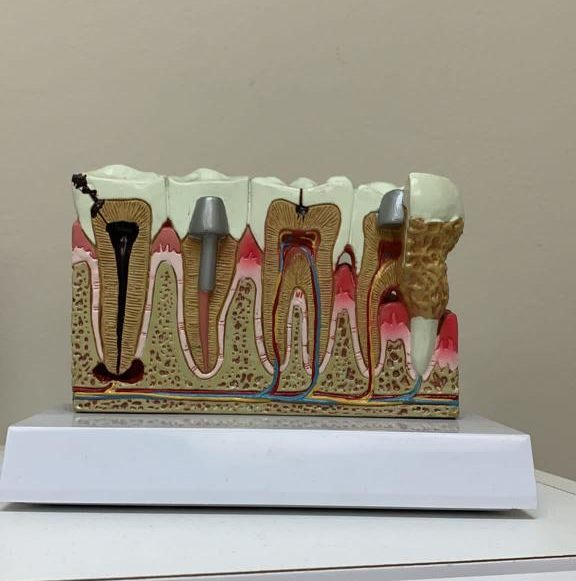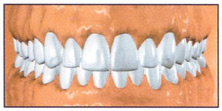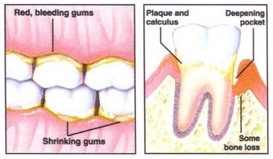Periodontal (gum) disease, is an infection caused by plaque. Plaque is the sticky film composed mostly of bacteria that forms continuously on the teeth and must be removed daily to prevent tooth decay and gum disease. If not removed, plaque bacteria produce toxins that irritate gum tissues causing them to swell. Gradually plaque hardens into calculus (tartar), that forms a rough surface on which more plaque accumulates, causing increased irritation and swelling.
This inflammation damages the periodontal fibers that hold the gums tightly against the teeth, creating spaces known as periodontal pockets. These pockets create room for even more bacterial activity which creates deeper pockets until eventually the bone supporting the tooth is destroyed, resulting in tooth loss.
Other factors can also cause periodontal disease. These include local irritants such as smoking, chewing tobacco, or habitually clenching the teeth. Nutrition, certain medications, and high levels of stress can also be contributing factors.
In many cases periodontal disease begins at an early age and in its first stages is called gingivitis (gum inflammation); with the more advanced stage known as periodontitis or pyorrhea. Because the disease can be virtually painless, it is important to maintain regular check-ups so that your dentist can detect the presence of periodontal disease, however, they may refer you to a periodontist (a specialist in diagnosing, treating and preventing gum disease). Your periodontist does a more in- depth examination to determine the actual extent of your periodontal disease.

The earlier you treat periodontal disease, the easier it is to control, and the better chance you have of restoring the health of your mouth and saving your teeth.
In a healthy mouth, teeth fit snugly in their sockets, their roots surrounded by a strong foundation of gums and other supportive tissue.

If not removed from teeth and bacteria grow out of control and produce toxins that irritate your gums. Calculus along the gumline forms a rough surface on which plaque accumulates, causing more irritation and swelling. You may notice sore, bleeding gums or bad breath. Spaces between the gum and tooth (pockets) may exist, but no bone is damaged in this mild, reversible form of periodontal disease.

The most cause of periodontitis, plaque (and sometimes calculus) is found bellow the gumline. The ligaments break down and the gum detaches and pulls away from the teeth. The pockets deepen and fill with more bacteria. Supportive ligaments and bone start to show damage, resulting in loose teeth.

In the advanced stage, pockets deepen and may fill with pus. There maybe swelling around the root and bone loss increases, your teeth may lose so much support that they fall out or need to be removed to preserve the overall health of your mouth.

At home, you can be on the alert for the warning signs of periodontal disease. If you have any of the following symptoms, see your dentist at once:
Non – surgical therapy removes plaque and calculus by controlling the growth of harmful bacteria and by treating conditions that encourage gum disease. These types of treatments may be all that’s needed:
Soling and root planing – Scaling is removing the calculus deposits from your teeth; root planing is the smoothing of the root surfaces so that the gum tissue can reattach to the tooth.
Curettage removes the soft tissue the periodontal pocket. This helps the gum tissue to heal.
Surgical therapy may be necessary to remove periodontal pockets when the disease is more advanced. Because bone tissue that has been destroyed does not grow back, special techniques are used: Gingivectomy involves removing an overgrowth of gum tissue. Removing excess gum tissue eliminates the space in which bacteria can collect. Flap surgery allows us to gain access to the root of the tooth for removal of calculus, plaque and diseased tissue. The gum is then secured back into place. Flap surgery is sometimes accompanied by osseous (bone) surgery, in which the bone around the tooth is reshaped or part of it is removed.
Good periodontal health starts with the you. Here’s what you can do to prevent or control gum disease:
